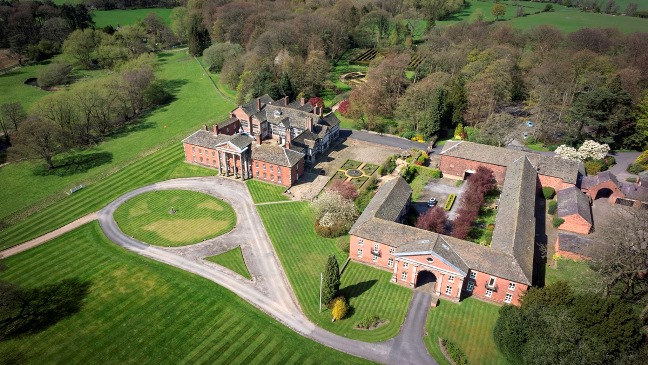 Aerial view of Adlington Hall
Aerial view of Adlington Hall
Sssh! Keep it quiet. Don’t say anything to the Legh family of Lyme but they are not the main branch of the family. The Leghs of Adlington are the senior branch and Adlington Hall has been handed down, generation by generation, all the way to Camilla, the current owner. The Leghs of Lyme are descended from a younger son who was sent out to make his fortune and fell on his feet by marrying well.
Anne Woods gave us a history of the Legh family, artfully interweaving it with a visual tour of the house and garden. Just to keep us on our toes she introduced the odd picture from time to time showing mystery objects whose function or origin we had to guess. But more about those later.
The Leghs might be the senior branch of the family but, in relation to the house, they were mere parvenues. There was a hunting lodge on the site in pre-Conquest times, occupied by the Anglo-Saxon Earl Edwin. He managed to survive the Conquest but not for long. He was involved in rebellion and Adlington was laid to waste as William first put down rebellions then ravaged the land as part of his “Harrying of the North.” Earl Edwin was killed in 1071 but even fifteen years later, at the time of the Domesday Book, the estate was only worth one shilling, down from eigh Organt shillings in pre-Conquest times.
Organt shillings in pre-Conquest times.
The estate was at first given to the Earls of Chester but, after reverting once more to the Crown, John de Legh became the holder in 1315 and his son Robert, proclaimed himself the first of the Legh family in 1352. As you might expect with any house that has been occupied as long as this, parts were built at different times. It forms a simple square with the South and West wing being Georgian, the East wing Elizabethan and the North front mainly seventeenth century. However, the oldest part is the Great Hall which dates from 1480. Two great oak pillars are reputed to have been there when the Great Hall was built around them but, though still there, this is probably a foundation myth. At one end of the Great Hall is one of the finest seventeenth century organs which probably at one time graced a royal chapel. At the other end is a huge canopy decorated with the shields of the great families of Cheshire in about 1580.
It was at this time that the Elizabethan wing was built but there had been a procession of Leghs, mainly called Robert, throughout its history. One married a paramour of Cardinal Wolsey at the Cardinal’s request. He had lived with her for ten years before she became an embarrassment as he rose up the church hierarchy. Another Legh was knighted for his efforts in the capture of Cadiz and yet another fought at the time of the Civil War. The house was captured by the parliamentary forces twice during that time; briefly in 1642 and then again in 1644 when it was confiscated. Twelve years later it was bought back and there is a picture of Legh with his betrothed. We know it was that occasion as the two were holding hands without wearing gloves. How intimate!
The big change came in the eighteenth century. Charles Legh had inherited money from his mother and also had a wealthy wife so he used the money to convert the house from a relatively modest building to a really sizeable manor. Not only that but he created an impressive garden with all the fashionable features of the time. One of those features was a stone bath where he could bathe alfresco, contemplating his achievements. Needless to say he incurred enormous debts but he had a lot to show for it. The house was doubled in size, a stable block was built almost as big as the house itself, and he even finished off with a dovecote.
The garden he established is one Inlaid ivory sewing box of the few rococo gardens in England. He planted over a thousand trees but the key elements of this type of design is the unexpected views. A bridge, a cascade, a Temple to Diana, even a hermitage - Adlington had them all. Over the years many of these features had fallen into disrepair and many had been lost, but in more recent times they have been rediscovered and conserved.
Inlaid ivory sewing box of the few rococo gardens in England. He planted over a thousand trees but the key elements of this type of design is the unexpected views. A bridge, a cascade, a Temple to Diana, even a hermitage - Adlington had them all. Over the years many of these features had fallen into disrepair and many had been lost, but in more recent times they have been rediscovered and conserved.
Similarly with the house. By the early twentieth century it was too big and too expensive to maintain. The decision was taken to demolish much of the house and the ancillary buildings and this was done in the 1920s. The downsizing achieved its purpose and money was spent on repairing and conserving the remaining parts so the house nowadays is much more manageable and the stable block has been converted for commercial uses. It seems an oxymoron to talk about a stately home designed for modern living but that is what Adlington Hall has become after six hundred years.
But what about the mystery objects? Where do they come in? The fireside bellows. The inlaid ivory sewing box. The narwhal tusk. The nutmeg grater. The carved artichokes. The 63 medieval bee hives. These are all items you can see when we visit Adlington in May. When the guide asks us what they are you can have your answers ready.

